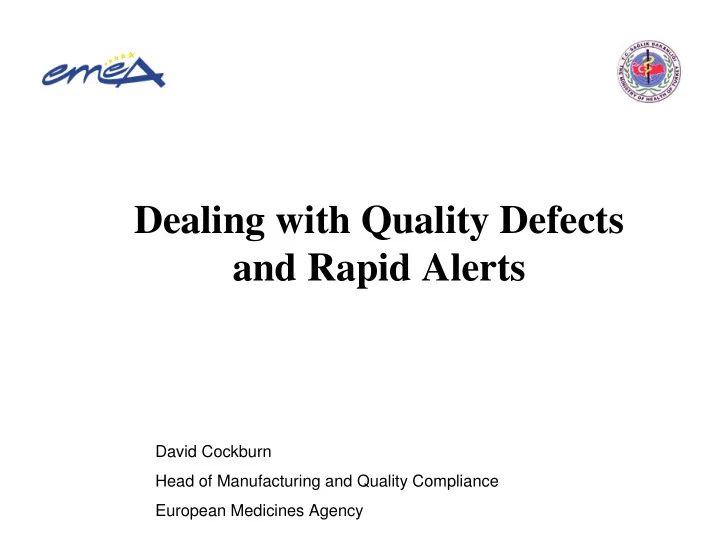

Dealing with Quality Defects and Rapid Alerts David Cockburn Head of Manufacturing and Quality Compliance European Medicines Agency
Contents • Responsibilities • Procedures for quality defects • Related procedures – GMP non-compliance – CEP suspension/revocation
Responsibilities of Manufacturing Authorisation Holders (1) • Article 13 of Directive 2003/94/EEC (and 91/412/EEC) – Must have a systems for • Recording and reviewing complaints • Recalling medicinal products in the distribution network – Obliged to report to their Competent Authority any defect in a medicinal product handled under their authorisation that could result in a recall or abnormal restriction in supply.
Responsibilities of Manufacturing Authorisation Holders (2) • EU GMP Guide 8.8 – The Competent Authority should be informed if a manufacturer is considering action following: • possibly faulty manufacture • product deterioration • detection of counterfeiting • any other serious quality problems with a product • EU GMP Guide 6.32 – Need to inform the competent authority of out of specification results and adverse trends from ongoing stability monitoring
Responsibilities: Wholesale Distribution Authorisation Holder • Art 80 Directive 2001/83/EC (and Art 65 2001/82/EC) : the Wholesale Distribution Authorisation Holder : • Must have an emergency plan to ensure effective implementation of any recall from the market ordered by the authorities, in cooperation with the manufacturer or marketing authorisation holder
Responsibilities: Member States • Article 117 of Directive 2001/83/EC and Article 83 of Dir 2001/82/EC – Responsibility to take all appropriate measures to ensure that medicinal product batches are withdrawn from the market if • harmful under normal conditions of use • composition not as declared • the controls on the finished product or during the manufacturing process or other requirement of the manufacturing authorisation not fulfilled • Article 2 of Directive 2003/94/EC – Compilation of Community Procedures – Handling suspected Quality Defects – Rapid Alerts – Dealing with GMP non-compliance
Procedure • Each National Competent Authority (NCA) must have a contact point for reporting suspected quality defects – Many NCAs have a special format for being informed • The NCA that receives the defect notification is responsible for dealing with it – May delegate it to the Supervisory Authority – If a centrally authorised product is involved EMEA should be informed and will coordinate the process • NCA evaluates the information provided by the MAH – It may require further information • If a recall is necessary this is agreed with the MAH
Defect notification received by EMEA • The MAH sends the Defective Product Report Form, with information on: – Details on the affected product & batches (including distribution) – Nature of the defect – Preliminary investigation report – Risk assessment to public health – Actions taken/planned/proposed – Any previous contacts with other authorities (who may have already assessed the issue)
Classification of Quality Defects – Class 1 • Defects, which are potentially life-threatening or could cause serious risk to health. – Class 2 • Defects, which could cause illness or mistreatment but are not Class 1. – Class 3 • Defects which may not pose a significant hazard to health but where a recall has been initiated (perhaps not required by the competent authority) for other reasons, but are not Class 1 or 2.
Time Scales • Class 1: immediate action with minimum delay • Class 2: within 24 hours or less • Class 3: within 48 hours if possible
Rapid Alert distribution list • EMEA maintains a Rapid Alert list – Includes all EEA Member States, MRA partners, WHO and PIC/S participating authorities • Class 1 and Class 2 Rapid Alerts are transmitted by the initiating authority to the whole list except for class 2 alerts where the distribution of affected batches is known.
National Competent Authority Actions on receiving a Rapid Alert • Investigation as to whether the affected product/batch(es) are on its own market • If so, initiate its own procedure for recall – The MAH activates the recall – Depending on national procedures the authority may also alert potential recipients of the batch • Monitor the conduct and effectiveness of the recall
GMP non-compliance • GMP non-compliance notification – Issued via EudraGMP to Rapid Alert contact list – Issuing authority indicates actions taken or proposed – Teleconference may be convened – Affected NCAs take coordinated action • Potential actions – Full or partial suspension of MIA or MA – Variation of MIA or MA – Recall of product(s)/batch(es) – Suspension of QP – Prohibition of supply – Suspension of clinical trials – Suspension of CEP
CEP (Certificate of European Pharmacopoeia) suspension • Notified by EDQM via its own contact list • CEP suspension invalidates affected marketing authorisations • NCAs and EMEA take appropriate action – Suspend MAs – Vary MAs – Recall of product(s)/batch(es) • Suspension of CEP may be triggered by GMP non-compliance
Thank you for your attention! http://www.emea.europa.eu/Inspections/Defects.html
Recommend
More recommend